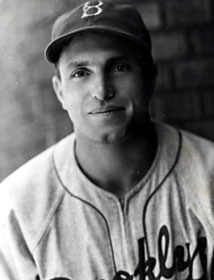The other half of the Yankees-Dodgers rivalry was Brooklyn. Unlike the Yanks, the Dodgers hadn’t been overly successful, especially during the “Daffiness Boys” Days of the 1930s. By 1941 that had all changed.
Leo Durocher was now the manager. He’d come over from St. Louis as a shortstop, had become the player-manager of the late 1930s, and was still doing a little field time in 1941. He’d led the team to 100 wins and its first pennant since 1920 (a World Series loss to Cleveland). The hitters dominated the National League ending up first in runs, hits, doubles, triples, total bases, home runs, average and almost everything else (they were next-to-last in stolen bases). The staff wasn’t quite as good, only leading the NL in hits and ERA. But they were second in runs allowed and shutouts, running third in both walks and strikeouts.
It was a veteran staff. Of the primary starters, only Kirby Higbe was under 30 (he was 26). He tied for the team lead with 22 wins, had an ERA just over three (ERA+ of 118), a 1.262 WHIP, walked more men than he struck out, and put up 3.4 WAR. The other team ace was Whit Wyatt (who was 33). He also had 22 wins, but his ERA was 2.34, with a team leading ERA+ of 159 (among pitchers with 15 or more starts). He led the team with 7.6 WAR, a 1.058 WHIP, and managed to strikeout about two men for every one he walked. Curt Davis’ 13 wins were the most by any other starter. His ERA was under three (2.97) while fourth starter Luke Hamlin had an ERA north of four. Fred Fitzsimmons was only in 13 games in 1941, was 39, and overweight. He parlayed all that into a 6-1 record with a 2.07 ERA and a 180 ERA+. Also under thirty (at 27) was Hugh Casey, the primary man out of the bullpen. He was in 45 games, started 18, pitched 162 innings and was almost dead even in walks to strikeout ratio (57 to 61). Of the rest of the staff, no one won more than three games, or pitched 60 innings (Johnny Allen had 57 innings).
From first around to third, the infield consisted of an MVP, two Hall of Famers, and a player later famous for a single hit. The MVP was first baseman Dolph Camilli. He’d come over from the Phillies and proceed to lead the team in home runs (34), RBIs (120), walks, and strikeouts. His OPS+ came in at 164 with an infield high of 6.8 WAR. Billy Herman was at second (and the first of the Hall of Fame duo). He’d come over from Chicago and led the infield with 156 hits and put up 3.6 WAR. PeeWee Reese was both the shortstop and the other infielder to make the Hall of Fame. He hit only .229 and had 2.0 WAR. He led National League shortstops in both putouts and errors. Cookie Lavagetto held down third. He hit .277, drove in 78 runs, had 2.7 WAR, and was still six years from his most famous hit (a double in the 1947 World Series to break up a no-hitter). Lew Riggs, Alex Kampouris, and Pete Coscarart were the main backups. Both Riggs and Kampouris hit above .300 and Riggs led the subs with five home runs. Manager Leo Durocher got into 18 games, 13 in the middle of the infield.
The outfield was Pete Reiser, Dixie Walker, and Ducky Joe Medwick. Medwick was a recent pickup from St. Louis and four years from his Triple Crown. He still hit well, .318 with 18 home runs and 88 RBIs. There’s an argument that his home run total was suppressed by Ebbets Field. That may be true, but it had been dropping for a couple of years. He showed 141 OPS+ and 4.6 WAR over 133 games. Reiser had some claim to being both the team and league MVP (although Camilli won the league award). He hit an NL high .343 with a .558 slugging percentage and .964 OPS, an OPS+ of 164 and 299 total bases. All led the league. His WAR was 7.4 (it would be his career high) in 137 games. For a player known for his speed, he stole only four bases (tied for third on the team). Walker was not yet the figure of scorn that later fans heaped on him for his opposition to Jackie Robinson. He hit .311, with nine homers (fourth on the team) and 71 RBIs (good for fifth on the team). The primary backup men were Jimmy Wasdell and Joe Vosmik. Wasdell had four home runs and hit .298. Future Hall of Famer Paul Waner, at the end of his career, appeared in 11 games and hit a buck-71.
All of which brings me to the catchers: Mickey Owen and Herman Franks. Owen was the primary catcher with Franks spelling him. Although he’d been up since 1937, Owen was new with the Dodgers. In his first year with the team he’d been an All-Star, hitting only .231 with a single homer. But he was considered a terrific catcher, showing a .995 fielding percentage, a 52% caught stealing percentage, and allowing only two passed balls all year. Franks, who would later make a name for himself as a manager, hit only .201 and wasn’t as good behind the plate as Owen.
The Dodgers, the new kids on the block, were decided underdogs in 1941, but they brought an energy to baseball that had been missing for several years. They weren’t expected to win, but they were expected to bring joy to Hilda Chester and her bell along with the Sym-Phony band.





